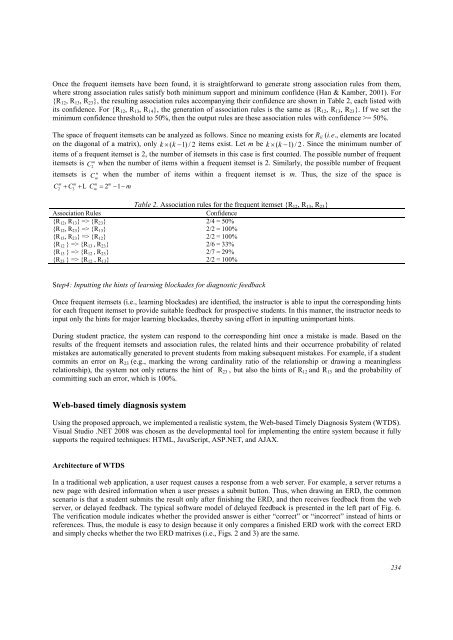Download Complete Issue in PDF - Educational Technology & Society
Download Complete Issue in PDF - Educational Technology & Society
Download Complete Issue in PDF - Educational Technology & Society
You also want an ePaper? Increase the reach of your titles
YUMPU automatically turns print PDFs into web optimized ePapers that Google loves.
Once the frequent itemsets have been found, it is straightforward to generate strong association rules from them,<br />
where strong association rules satisfy both m<strong>in</strong>imum support and m<strong>in</strong>imum confidence (Han & Kamber, 2001). For<br />
{R12, R13, R23}, the result<strong>in</strong>g association rules accompany<strong>in</strong>g their confidence are shown <strong>in</strong> Table 2, each listed with<br />
its confidence. For {R12, R13, R14}, the generation of association rules is the same as {R12, R13, R23}. If we set the<br />
m<strong>in</strong>imum confidence threshold to 50%, then the output rules are these association rules with confidence >= 50%.<br />
The space of frequent itemsets can be analyzed as follows. S<strong>in</strong>ce no mean<strong>in</strong>g exists for Rii (i.e., elements are located<br />
on the diagonal of a matrix), only k× ( k−<br />
1) / 2 items exist. Let m be k× ( k−<br />
1) / 2 . S<strong>in</strong>ce the m<strong>in</strong>imum number of<br />
items of a frequent itemset is 2, the number of itemsets <strong>in</strong> this case is first counted. The possible number of frequent<br />
m<br />
itemsets is C when the number of items with<strong>in</strong> a frequent itemset is 2. Similarly, the possible number of frequent<br />
2<br />
itemsets is m<br />
C when the number of items with<strong>in</strong> a frequent itemset is m. Thus, the size of the space is<br />
m<br />
m m m m<br />
C2 + C3 + L C = 2 −1−m m<br />
Table 2. Association rules for the frequent itemset {R12, R13, R23}<br />
Association Rules Confidence<br />
{R 12, R 13} => {R 23} 2/4 = 50%<br />
{R12, R23} => {R13} 2/2 = 100%<br />
{R13, R23} => {R12} 2/2 = 100%<br />
{R 12 } => {R 13 , R 23} 2/6 = 33%<br />
{R 13 } => {R 12 , R 23} 2/7 = 29%<br />
{R23 } => {R12 , R13} 2/2 = 100%<br />
Step4: Inputt<strong>in</strong>g the h<strong>in</strong>ts of learn<strong>in</strong>g blockades for diagnostic feedback<br />
Once frequent itemsets (i.e., learn<strong>in</strong>g blockades) are identified, the <strong>in</strong>structor is able to <strong>in</strong>put the correspond<strong>in</strong>g h<strong>in</strong>ts<br />
for each frequent itemset to provide suitable feedback for prospective students. In this manner, the <strong>in</strong>structor needs to<br />
<strong>in</strong>put only the h<strong>in</strong>ts for major learn<strong>in</strong>g blockades, thereby sav<strong>in</strong>g effort <strong>in</strong> <strong>in</strong>putt<strong>in</strong>g unimportant h<strong>in</strong>ts.<br />
Dur<strong>in</strong>g student practice, the system can respond to the correspond<strong>in</strong>g h<strong>in</strong>t once a mistake is made. Based on the<br />
results of the frequent itemsets and association rules, the related h<strong>in</strong>ts and their occurrence probability of related<br />
mistakes are automatically generated to prevent students from mak<strong>in</strong>g subsequent mistakes. For example, if a student<br />
commits an error on R23 (e.g., mark<strong>in</strong>g the wrong card<strong>in</strong>ality ratio of the relationship or draw<strong>in</strong>g a mean<strong>in</strong>gless<br />
relationship), the system not only returns the h<strong>in</strong>t of R23 , but also the h<strong>in</strong>ts of R12 and R13 and the probability of<br />
committ<strong>in</strong>g such an error, which is 100%.<br />
Web-based timely diagnosis system<br />
Us<strong>in</strong>g the proposed approach, we implemented a realistic system, the Web-based Timely Diagnosis System (WTDS).<br />
Visual Studio .NET 2008 was chosen as the developmental tool for implement<strong>in</strong>g the entire system because it fully<br />
supports the required techniques: HTML, JavaScript, ASP.NET, and AJAX.<br />
Architecture of WTDS<br />
In a traditional web application, a user request causes a response from a web server. For example, a server returns a<br />
new page with desired <strong>in</strong>formation when a user presses a submit button. Thus, when draw<strong>in</strong>g an ERD, the common<br />
scenario is that a student submits the result only after f<strong>in</strong>ish<strong>in</strong>g the ERD, and then receives feedback from the web<br />
server, or delayed feedback. The typical software model of delayed feedback is presented <strong>in</strong> the left part of Fig. 6.<br />
The verification module <strong>in</strong>dicates whether the provided answer is either “correct” or “<strong>in</strong>correct” <strong>in</strong>stead of h<strong>in</strong>ts or<br />
references. Thus, the module is easy to design because it only compares a f<strong>in</strong>ished ERD work with the correct ERD<br />
and simply checks whether the two ERD matrixes (i.e., Figs. 2 and 3) are the same.<br />
234

















